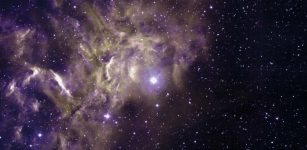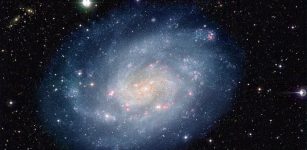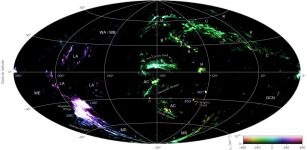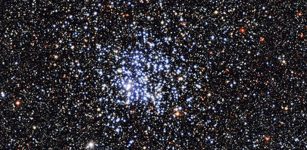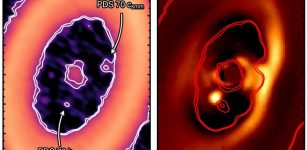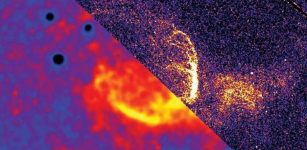A Pair Of Quasars In Merging Galaxies Spotted By Hubble
Eddie Gonzales Jr. – MessageToEagle.com – Hubble astronomers found a pair of quasars that are so close to each other they look like a single object in ground-based telescopic photos, but not in Hubble’s crisp view.
 This artist’s conception shows the brilliant light of two quasars residing in the cores of two galaxies that are in the chaotic process of merging. The gravitational tug-of-war between the two galaxies stretches them, forming long tidal tails and igniting a firestorm of starbirth… more
This artist’s conception shows the brilliant light of two quasars residing in the cores of two galaxies that are in the chaotic process of merging. The gravitational tug-of-war between the two galaxies stretches them, forming long tidal tails and igniting a firestorm of starbirth… more
The researchers believe the quasars are very close to each other because they reside in the cores of two merging galaxies. The team went on to win the “daily double” by finding yet another quasar pair in another colliding galaxy duo.
A quasar is a brilliant beacon of intense light from the center of a distant galaxy that can outshine the entire galaxy. It is powered by a supermassive black hole voraciously feeding on inflating matter, unleashing a torrent of radiation. Quasars are scattered all across the sky and were most abundant 10 billion years ago. Astronomers have discovered more than 100 double quasars in merging galaxies so far. However, none of them is as old as the two double quasars in this study.
“We estimate that in the distant universe, for every 1,000 quasars, there is one double quasar. So finding these double quasars is like finding a needle in a haystack,” lead researcher Yue Shen of the University of Illinois at Urbana-Champaign said in a press release.
The discovery of these four quasars offers a new way to probe collisions among galaxies and the merging of supermassive black holes in the early universe, researchers say.
“This truly is the first sample of dual quasars at the peak epoch of galaxy formation with which we can use to probe ideas about how supermassive black holes come together to eventually form a binary,” said research team member Nadia Zakamska of Johns Hopkins University in Baltimore, Maryland.
The observations are important because a quasar’s role in galactic encounters plays a critical part in galaxy formation, the researchers say. As two close galaxies begin to distort each other gravitationally, their interaction funnels material into their respective black holes, igniting their quasars.
Over time, radiation from these high-intensity “light bulbs” launches powerful galactic winds, which sweep out most of the gas from the merging galaxies. Deprived of gas, star formation ceases, and the galaxies evolve into elliptical galaxies.
“Quasars make a profound impact on galaxy formation in the universe,” Zakamska said. “Finding dual quasars at this early epoch is important because we can now test our long-standing ideas of how black holes and their host galaxies evolve together.”
The Hubble images show that quasars within each pair are only about 10,000 light-years apart. By comparison, our Sun is 26,000 light-years from the supermassive black hole in the center of our galaxy.
The pairs of host galaxies will eventually merge, and then the quasars also will coalesce, resulting in an even more massive, single solitary black hole. To this discovery contributed the European Space Agency’s Gaia satellite and the ground-based Sloan Digital Sky Survey (at Apache Point Observatory in New Mexico) to compile a group of potential candidates for Hubble to observe.
The quasars aren’t moving through space in any measurable way, but instead, their jiggle could be evidence of random fluctuations of light as each member of the quasar pair varies in brightness. Quasars flicker in brightness on timescales of days to months, depending on their black hole’s feeding schedule.
When the first four targets were observed with Hubble, its crisp vision revealed that two of the targets are two close pairs of quasars. The researchers said it was a “light bulb moment” that verified their plan of using Sloan, Gaia, and Hubble to hunt for the ancient, elusive double powerhouses.
Galactic mergers were more plentiful billions of years ago, but a few are still happening today. One example is NGC 6240, a nearby system of merging galaxies that has two and possibly even three supermassive black holes. An even closer galactic merger will occur in a few billion years when our Milky Way galaxy collides with the neighboring Andromeda galaxy.
Written by Eddie Gonzales Jr. – MessageToEagle.com Staff


